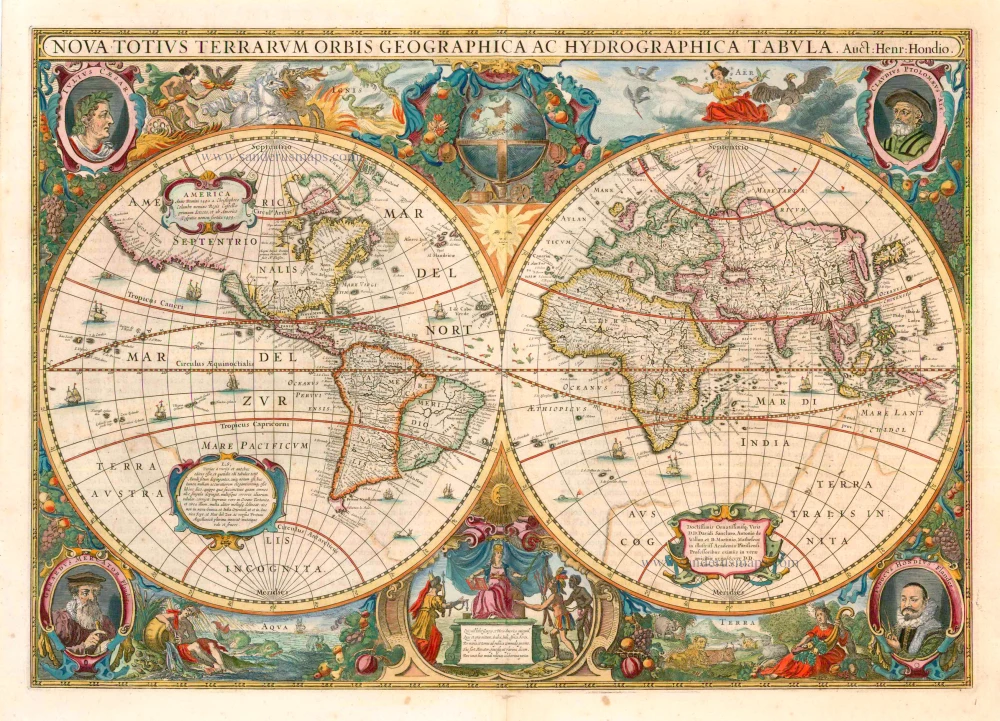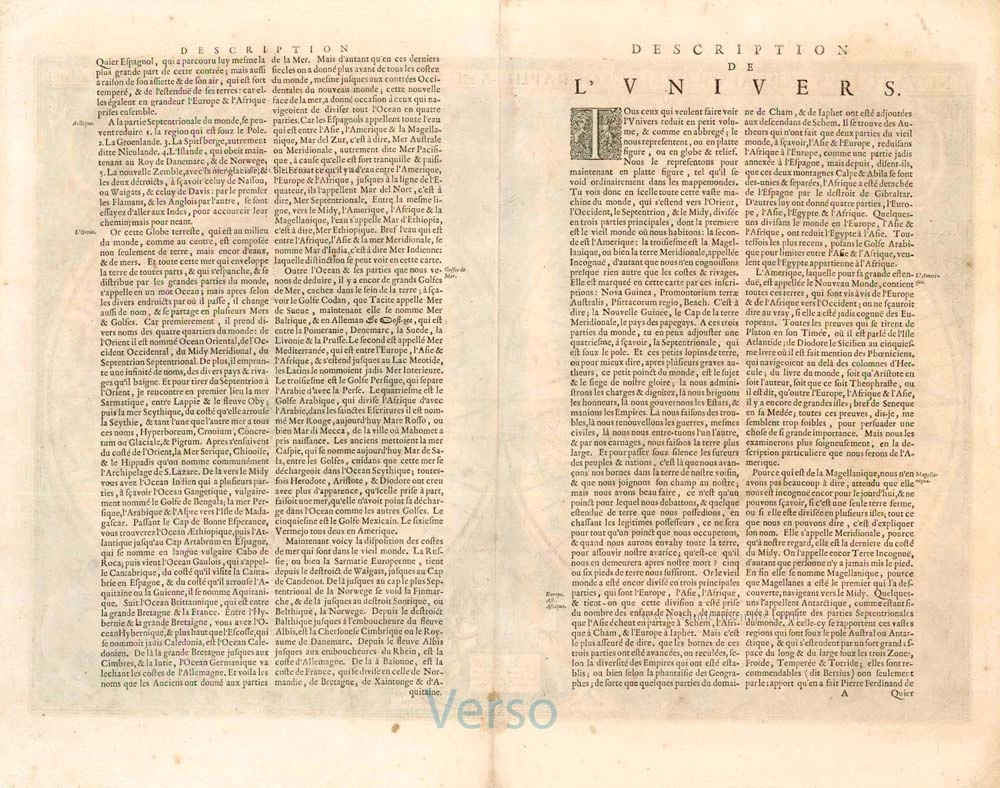Old, antique world map - double hemisphere by H. Hondius 1639-44
In 1629, threatened by pending competition from W.J. Blaeu and his sons, Jan Jansson and his partner Henricus Hondius set about revising the Mercator-Hondius atlas which (in respect of the world map) had continued unchanged for nearly thirty-five years. The partners' new world map is a fine ornate example of the decorative cartography of the time. The two hemispheres are bordered by voluptuous representations of the four elements and other scenes: in the top corners are portraits of Julius Caesar and Claudius Ptolemy and in the bottom corners are protraits of the author's father Jodocus Hondius and his mentor Gerard Mercator.
For geographical detail Hondius has followed Speed and his contemporaries and also presents California as an island. New features include part of the north Australia coastline extending towards New Guinea and a redrawing of north-east Canada with 'Queen Ann's forland' (Baffin Island) shown completeley encircled by open water.
The Hondius-Jansson world map had as a long a life as its predecessor, as it was included in all issues of the Mercator atlas from 1633 until at least 1658. Four states have been traced with dates on the map as follows (See Shirley):
State 1 1630
State 2 1641 with Amstelodami Excudit Ioannes Ianssonius added at the bottom
State 3 1663 in Atlas Contractus of Jan Jansson and in sea atlases of Van Loon
State 4 1666 in Atlas Major of Jan Jansson
The Janssonius Family
Joannes Janssonius (Arnhem, 1588-1664), son of the Arnhem publisher Jan Janssen, married Elisabeth Hondius, daughter of Jodocus Hondius, in Amsterdam in 1612. After his marriage, he settled down in this town as a bookseller and publisher of cartographic material. In 1618, he established himself in Amsterdam next door to Blaeu’s bookshop. He entered into serious competition with Willem Jansz. Blaeu when copying Blaeu’s Licht der Zeevaert after the expiration of the privilege in 1620. His activities concerned the publication of atlases, books, single maps, and an extensive book trade with branches in Frankfurt, Danzig, Stockholm, Copenhagen, Berlin, Koningsbergen, Geneva, and Lyon. In 1631, he began publishing atlases together with Henricus Hondius.
In the early 1640s, Henricus Hondius left the atlas publishing business to Janssonius. Competition with Joan Blaeu, Willem’s son and successor, in atlas production, prompted Janssonius to enlarge his Atlas Novus finally into a work of six volumes, into which a sea atlas and an atlas of the Old World were inserted. Other atlases published by Janssonius are Mercator’s Atlas Minor, Hornius’s historical atlas (1652), the townbooks in eight volumes (1657), Cellarius’s Atlas Coelestis and several sea atlases and pilot guides.
After the death of Joannes Janssonius, the shop and publishing firm were continued by the heirs under the direction of Johannes van Waesbergen (c. 1616-1681), son-in-law of Joannes Janssonius. Van Waesbergen added Janssonius's name to his own.
In 1676, Joannes Janssonius’s heirs sold by auction “all the remaining Atlases in Latin, French, High and Low German, as well as the Stedeboecken in Latin, in 8 volumes, bound and unbound, maps, plates belonging to the Atlas and Stedeboecken.” The copperplates from Janssonius’s atlases were afterwards sold to Schenk and Valck.
Nova Totius Terrarum Orbis Geographica ac Hydrographica Tabula
Item Number: 11998 Authenticity Guarantee
Category: Antique maps > World and Polar
Antique world map - double hemisphere by H. Hondius, with corner portraits of J. Caesar, Cl. Ptolemy, G. Mercator & J. Hondius. Insular California.
Date of the first edition: 1631
Date of this map: 1639
Date on map: 1630
Dedication to David Sanclarus, Antonius de Willon and Martinius by H. Hondius.
Copper engraving
Size: 38 x 54.5cm (14.8 x 21.2 inches)
Verso text: French
Condition: Hand coloured, excellent.
Condition Rating: A
References: Shirley (World), 336, State 1; Van der Krogt 1, 0001:1C.1.
From: Nouveau Theatre du Monde ou Nouvel Atlas. Amsterdam, J. Janssonius, 1639-44. (Van der Krogt 1, 412)
In 1629, threatened by pending competition from W.J. Blaeu and his sons, Jan Jansson and his partner Henricus Hondius set about revising the Mercator-Hondius atlas which (in respect of the world map) had continued unchanged for nearly thirty-five years. The partners' new world map is a fine ornate example of the decorative cartography of the time. The two hemispheres are bordered by voluptuous representations of the four elements and other scenes: in the top corners are portraits of Julius Caesar and Claudius Ptolemy and in the bottom corners are protraits of the author's father Jodocus Hondius and his mentor Gerard Mercator.
For geographical detail Hondius has followed Speed and his contemporaries and also presents California as an island. New features include part of the north Australia coastline extending towards New Guinea and a redrawing of north-east Canada with 'Queen Ann's forland' (Baffin Island) shown completeley encircled by open water.
The Hondius-Jansson world map had as a long a life as its predecessor, as it was included in all issues of the Mercator atlas from 1633 until at least 1658. Four states have been traced with dates on the map as follows (See Shirley):
State 1 1630
State 2 1641 with Amstelodami Excudit Ioannes Ianssonius added at the bottom
State 3 1663 in Atlas Contractus of Jan Jansson and in sea atlases of Van Loon
State 4 1666 in Atlas Major of Jan Jansson
In 1629, threatened by pending competition from W.J. Blaeu and his sons, Jan Jansson and his partner Henricus Hondius set about revising the Mercator-Hondius atlas which (in respect of the world map) had continued unchanged for nearly thirty-five years. The partners' new world map is a fine ornate example of the decorative cartography of the time. The two hemispheres are bordered by voluptuous representations of the four elements and other scenes: in the top corners are portraits of Julius Caesar and Claudius Ptolemy and in the bottom corners are protraits of the author's father Jodocus Hondius and his mentor Gerard Mercator.
For geographical detail Hondius has followed Speed and his contemporaries and also presents California as an island. New features include part of the north Australia coastline extending towards New Guinea and a redrawing of north-east Canada with 'Queen Ann's forland' (Baffin Island) shown completeley encircled by open water.
The Hondius-Jansson world map had as a long a life as its predecessor, as it was included in all issues of the Mercator atlas from 1633 until at least 1658. Four states have been traced with dates on the map as follows (See Shirley):
State 1 1630
State 2 1641 with Amstelodami Excudit Ioannes Ianssonius added at the bottom
State 3 1663 in Atlas Contractus of Jan Jansson and in sea atlases of Van Loon
State 4 1666 in Atlas Major of Jan Jansson
The Janssonius Family
Joannes Janssonius (Arnhem, 1588-1664), son of the Arnhem publisher Jan Janssen, married Elisabeth Hondius, daughter of Jodocus Hondius, in Amsterdam in 1612. After his marriage, he settled down in this town as a bookseller and publisher of cartographic material. In 1618, he established himself in Amsterdam next door to Blaeu’s bookshop. He entered into serious competition with Willem Jansz. Blaeu when copying Blaeu’s Licht der Zeevaert after the expiration of the privilege in 1620. His activities concerned the publication of atlases, books, single maps, and an extensive book trade with branches in Frankfurt, Danzig, Stockholm, Copenhagen, Berlin, Koningsbergen, Geneva, and Lyon. In 1631, he began publishing atlases together with Henricus Hondius.
In the early 1640s, Henricus Hondius left the atlas publishing business to Janssonius. Competition with Joan Blaeu, Willem’s son and successor, in atlas production, prompted Janssonius to enlarge his Atlas Novus finally into a work of six volumes, into which a sea atlas and an atlas of the Old World were inserted. Other atlases published by Janssonius are Mercator’s Atlas Minor, Hornius’s historical atlas (1652), the townbooks in eight volumes (1657), Cellarius’s Atlas Coelestis and several sea atlases and pilot guides.
After the death of Joannes Janssonius, the shop and publishing firm were continued by the heirs under the direction of Johannes van Waesbergen (c. 1616-1681), son-in-law of Joannes Janssonius. Van Waesbergen added Janssonius's name to his own.
In 1676, Joannes Janssonius’s heirs sold by auction “all the remaining Atlases in Latin, French, High and Low German, as well as the Stedeboecken in Latin, in 8 volumes, bound and unbound, maps, plates belonging to the Atlas and Stedeboecken.” The copperplates from Janssonius’s atlases were afterwards sold to Schenk and Valck.




